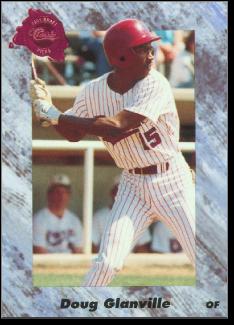
Sport: Baseball
Born: August 25, 1970
Town: Teaneck, New Jersey
Douglas Metunwa Glanville was born August 25, 1970 in Hackensack and grew up in neighboring Teaneck, NJ. Doug starred in Little League and modeled his game after Garry Maddox, the Gold Glove center fielder of the Philadelphia Phillies. Doug was also obsessed with the statistics and strategy of baseball, playing Strat-O-Matic games for hours on end. Doug’s older brother, Ken, acted as his coach, taking him from Wiffle Ball games through Little League all the way to Teaneck High. There Doug was in the same class as Rutgers football star Chris Brantley. One of his childhood friends was Lawrence Frank, the future coach of the New Jersey Nets.
Doug was a lanky 6’2” outfielder with a strong arm and live bat. A superb student, he opted to attend college rather than play pro ball, and let the teams scouting him know not to waste a draft pick. Instead of going with one of the powerhouse programs interested in him—including UNC, Miami and Clemson—he chose to enroll at the University of Pennsylvania. As a junior in 1991, he was All-Ivy and a preseason second-team All-American.
That spring, Doug was chosen by the Chicago Cubs with the 12th pick in the 1991 draft. He worked his way up from low-A to the majors in five years, combining speed, power and solid defense. Doug made his big-league debut in June 1996, and replaced Luis Gonzalez as the everyday leftfielder in 1997 after Gonzaalez left via free agency. Doug was second on the Cubs with a .300 average in ’97.
Following the season, the Cubs needed to replace second baseman Ryne Sandberg, who announced his retirement. They traded Doug to the Phillies for Mickey Morandini. Doug played Garry Maddox’s old position for the Phillies and batted leadoff. He led the NL in 1998 with 678 at bats and was tops on the team with 189 hits, 7 triples and 23 stolen bases.
In 1999, Doug enjoyed his finest season. He batted .325 and was second in the NL with 204 hits and first with 149 singles. He also stole a career-high 34 bases and was only caught twice for a league-best 94.4% success rate. Doug continued to lead off for the Phillies until August of 2001, when rookie Jimmy Rollins moved him down in the order. Doug enjoyed his best year from a power perspective in ’01, slugging 14 homers.
In 2002, the Phillies began benching Doug against tough righties. For all of his hitting talent, he tended to be impatient at the plate, and enemy pitchers were beginning to get the better of him. He left Philadelphia after the season and signed a free-agent deal with the Texas Rangers. At the trade deadline in 2003, the Rangers sold him to his original team, the Cubs. He contributed to Chicago’s exciting run in the playoffs, winning Game 3 of the NLCS with an 11th-inning triple. The Cubs went on to lose that series to the Marlins in seven games.
Doug returned to the Phillies in 2004 but hit just .210. He tried to catch on with the Yankees in 2005 but did not make the club in Spring Training. Before retiring, he signed a one-day contract with the Phillies so he could retire with his favorite team. After leaving the game, Doug wrote a column for The New York Times and later a book entitled The Game From Where I Stand.
Doug continues to write for newspapers and web sites, including The Athletic, and sits on the board of the MLB Players Alumni Association. He provides baseball commentary for ESPN and teaches a class at UConn, following in he footsteps of his parents, who were both educators.